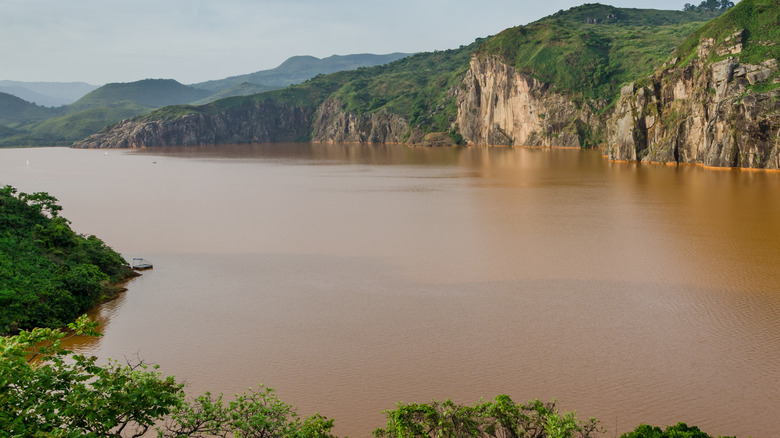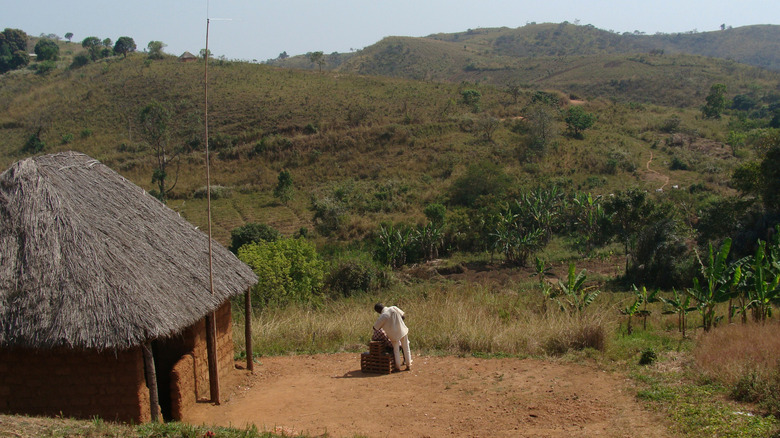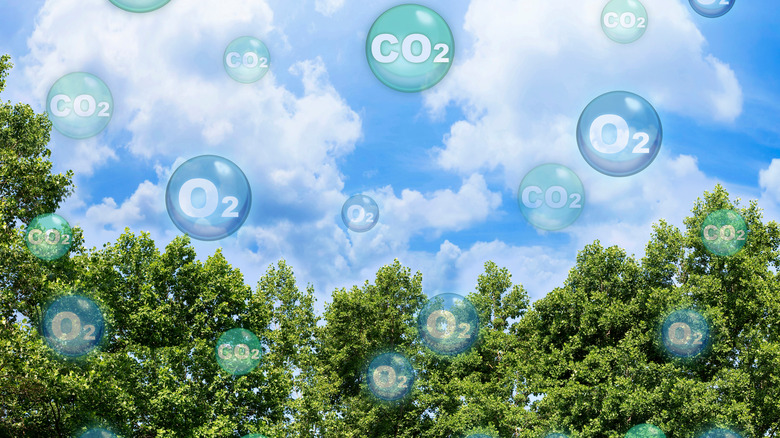This Erupting Lake In Cameroon Is One Of The Most Dangerous Places In The World
There's nothing quite as serene as standing at the precipice of a quiet lake, absorbing the contained landscape of the lacustrine ecosystem, stationary in its existence. Unless, of course, that lake is a permeable barrier between you and a pent-up earth-grenade of carbon dioxide.
This, unfortunately, was the disastrous reality for the villagers and cattle farmers who lived on land beneath Lake Nyos, located in northwest Cameroon. According to Smithsonian Magazine, on the night of August 21, 1986, Lake Nyos, a formerly crystal-blue crater lake became the epicenter of a cataclysmic event that nearly wiped out an entire village.
Those who miraculously survived the eruption described seeing a "strange white mist" rising from the lake and hearing a rumbling emanating from the earth. Before anyone could piece together what was happening, a gust of wind tore through the village, causing humans and animals alike to suddenly lose consciousness. Per an account reported by the Oregon State University, this cloud of gas, "grew bigger and taller, up to 100 meters [nearly 330 feet] in height, settled on the surface of the lake and started to flow down the valley, forming a river of white gas 50 meters [164 feet] tall." Carbon dioxide is denser than air, so the gas descended upon the village, showering everything in poison.
Even the flies didn't survive
Ephriam Che, a subsistence farmer who lived in a mud-brick home on a cliff overlooking the lake, told Smithsonian Magazine, "On that day there were no flies on the dead," meaning even the flies didn't survive. In total, almost 1,800 people and nearly 3,500 livestock lost their lives at Lake Nyos.
Prior to that evening, the lake was a peaceful resource for the village. With no previous volcanic activity, no one could've predicted the monster lurking beneath.
Even now, nearly 40 years, after the eruption, scientists still struggle to explain what triggered the calamitous "explosion." What is understood, however, is that crater-lakes with volcanic activity below the surface, typically process carbon dioxide in a way that is not harmful to living creatures — at least those found outside of the lake. Yes, there are harmful amounts of carbon dioxide gas in the far-reaching depths of the water, but they tend to dissolve into non-threatening amounts once they reach the surface. In the case of Lake Nyos, which is an impressive 683 feet deep, the carbon dioxide never had the chance to dissolve, instead, something triggered its sudden release, devouring the small village at its base.
Staving off another Apocolypse
Considering the rarity of this tragic phenomenon, very little is understood about how this actually happened. It is theorized that falling rock from a rockslide could've pierced the trapped gas at the bottom of the lake causing it to explode out — similar to a popped balloon. Another theory posits that a severe and unusual temperature drop, or strong winds, caused the water at the top of the lake to sink to the bottom, unleashing the carbon dioxide-infused water. However, scientists have yet to come up with a definitive answer. Yet, they are certain of one thing, "water saturated with carbon dioxide was displaced upward from the depths; as it rose and pressure lessened, dissolved carbon dioxide bubbled out of solution, and the bubbles drew more gas-laden water in their wake, and so on until the lake exploded like a huge shaken seltzer bottle" as reported by Smithsonian Magazine.
The painful death and destruction experienced in this small Cameroonian village, while unimaginable, has not been in vain. With some distance and time committed to the healing process from a tragedy such as this one, authorities in Cameroon have taken de-gassing measures to prevent something like this from occurring again.


